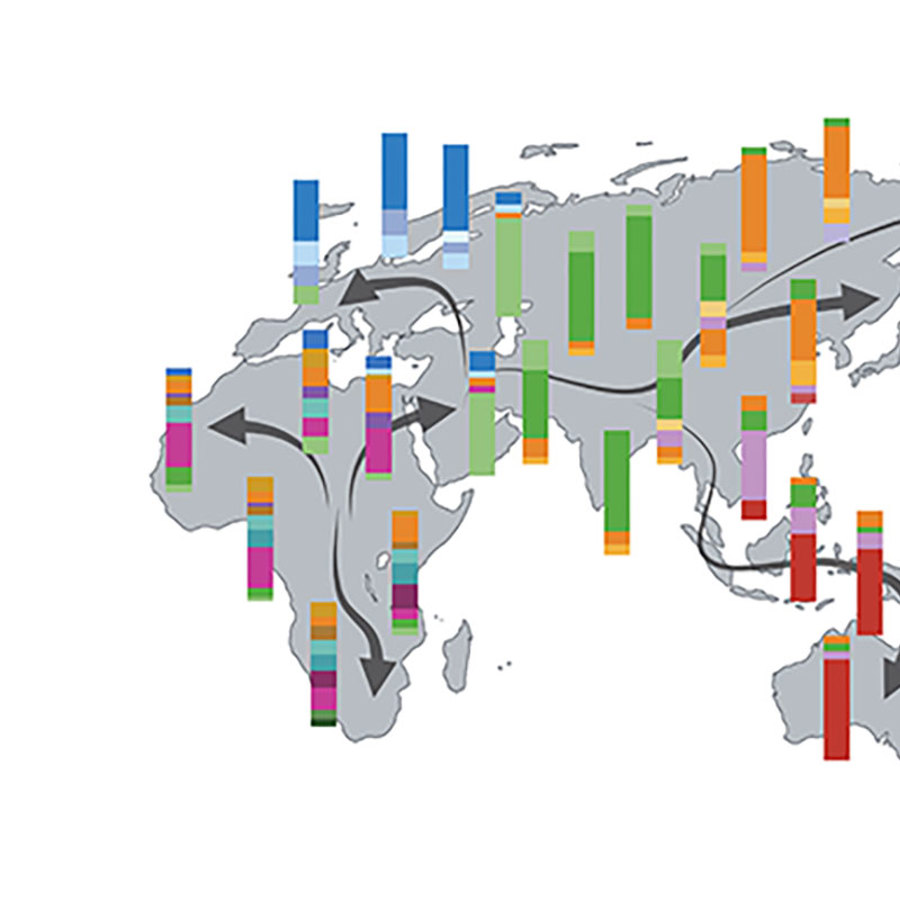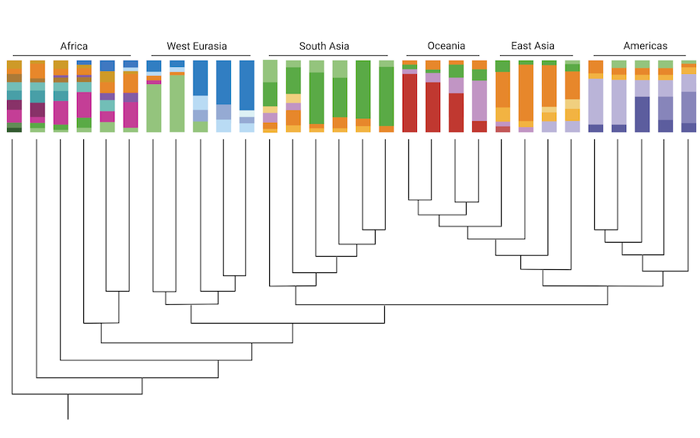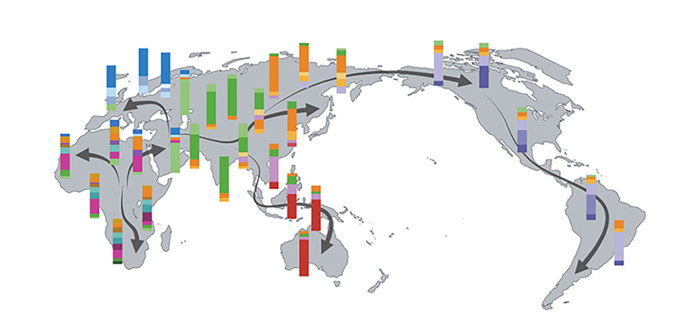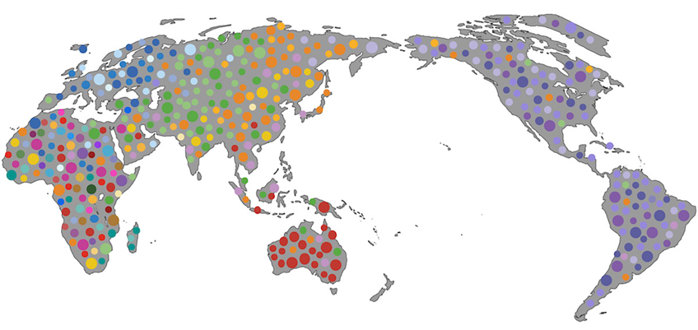
How do we know humans originated in Africa?
January 25, 2023

- Related Topics:
- Human evolution,
- Evolution,
- Ancestry
John from Toronto, ON asks:
“How do we know Africa is the cradle of modern humanity (homo sapiens)? Is it due to DNA research?”
Our human species, known as Homo sapiens, most likely evolved between 150,000 and 200,000 years ago. Humans are found on every continent in the world, but the reason we think our ancestors came from Africa is because of both fossil and DNA evidence.
We’ve looked for fossils from our ancient human ancestors all over the world. Of all of these, the oldest fossils we’ve discovered were found in Africa. If we look at fossils of ancient Homo sapiens that have been found in Europe and Asia, they’re not nearly as old.
Fossils evidence is incomplete though. Unfortunately, we just don’t have that many ancient fossils. That’s why each discovery is so exciting! Luckily, we also have DNA to verify what we’ve learned from fossils. Both types of evidence point to Africa as the place where Homo sapiens first originated.
If you’re curious how DNA can tell us about the location of our ancient ancestors, keep reading!
Fossilized in time
When Charles Darwin was working on his theory of evolution, he began to wonder about where the first humans came from. He guessed that our species might’ve evolved in Africa.1 But back in the 1800s while Darwin was alive, there were very few skeletons of ancient humans that had been discovered. There just wasn't much evidence to go off of.
Nearly a century later, archeologists uncovered fossilized parts of human skeletons in Omo Kibish, Ethiopia. Because the remains were so deep in the ground, they figured what they’d found was old, but they had no idea how old until they took them back to the lab. By using special types of elements in the soil, they learned the fossils were the oldest ever found, around 195,000 years old!2
Archeologists have also been hunting for skeletons on other continents. In the Middle East, ancient Homo sapien skeletons have been found dating back to 92,000 years ago. In Australia, the oldest ancient skeletons are 40,000 - 60,000 years old, and those in Europe are only 30,000 - 40,000 years old.3 Compared to the ancient skeletons found in Africa, the earliest human remains outside of Africa are really young, and they get younger the farther away from Africa that you get.
These patterns seem to suggest that Homo sapiens first originated in Africa, and then eventually spread out to occupy continents farther and farther away.
However, we can’t be entirely sure based on just fossils alone since ancient skeletons in good condition are hard to come by. Maybe we just haven’t found older skeletons of people in places outside of Africa because the conditions weren’t right for them to be preserved? Maybe it's just really hard to find ancient fossils. Could it be that they exist but just haven’t been found yet?
But this doesn’t seem likely. Scientists don’t have any problem finding human fossils that are older than the ones found in Africa. But none of these older fossils belong to our species of human! We’ve found fossils and artifacts dating older than 200,000 years in Europe and Asia, but they belong to our closest relatives the Neanderthals (Homo neanderthalensis), the Denisovans (Homo denisova), Homo erectus,and others.4,5
The skeletons of these other human species look very similar to us, but they’re different enough to tell apart.6 Archaeologists can use features of skeletons like skull shape and size to distinguish whether they are our ancestors or more distant cousins.

It turns out that other human species probably lived in parts of Europe and Asia much earlier than the ancient Homo sapiens found in Africa. But if our closest relatives lived outside of Africa, why do we think modern humans originated in Africa?
It's clear we need more information, and lucky for us, DNA contains loads of this.
Tree of humanity
We can learn more about human origins by looking at the DNA of people alive today. By looking at how people around the world are related to each other, we can start to figure out where their ancestors are from.
Over time DNA can accumulate changes called mutations. These mutations occur randomly and, for the most part, at a roughly constant rate over time.7 This means that DNA sequences that are more distantly related will have more differences than DNA sequences that are more closely related.
The different spots on the genome where these mutations have occurred are called genetic markers. We can compare your markers to those from different populations around the world to determine where in the world your closest relatives and ancestors lived.
For example, people from India share more genetic markers with people from Bangladesh than with those from Ireland. This is because people from India and Bangladesh are more closely related. This is how ancestry tests like 23andMe and AncestryDNA work.
Something similar can be done to figure out our human ancestry. Scientists can compare the genetic markers of different populations to build a big family tree. In the image below, you can see an example of how this family tree would look.

In this family tree, the bars at the tip of each branch represent different indigenous populations from across the world. The colors in each bar represent different genetic markers found in that population. Colors that are shared between different populations show genetic markers that are shared.
One important note here is that the genome of all modern day humans is >99.9% identical. So, when we’re talking about differences between different populations, we’re focusing only on those <0.1% of differences between people.
Two bars that are more closely connected have a more recent common ancestor. Bars that are separated by many branch points have a more ancient common ancestor. Notice that no matter which branch in the tree you start at, if you trace far enough back, it will connect with a branch from an indigenous African population.
The fact that all branches converge with African populations is a key piece of genetic evidence supporting the theory that all humans originated in Africa.
We can use this family tree along with information about where people currently live to figure out how people moved around the world.

For example, Aboriginal Australians share many of their genetic markers with Papuans from New Guinea. This suggests that the ancient ancestors of Aboriginal Australians came from New Guinea, probably before these two countries were separated by ocean. More broadly, both groups share markers with East Asians. This is why scientists believe that humans first traveled from Africa to Asia and then to the Pacific Islands and Australia.10
Scientists can also use our human family tree to predict the age of our most recent common ancestor. They start by making certain assumptions about the rate that mutations accumulate and the time in between generations. They can use this to estimate the time it would have taken for all the different genetic markers in humans today to appear from a single ancestor.
Diversity city
Another piece of modern DNA evidence that we can look at is genetic diversity. In this case, when we’re talking about diversity, we mean the number of different genetic characteristics that are present within a single population.
When we look at the genetic diversity of populations all across the globe, it is highest in African populations. Some of the same genetic markers are also found outside of Africa, but these are only a fraction of the markers that are found within Africa.
This fits with what we would expect. If humans originated in Africa, and lived there the longest, there would be more time for changes to accumulate in the DNA of the people living in that area.
Most people believe that humans traveled out of Africa in small groups. Because of this, the people who settled Europe and Asia were probably not representative of the much larger group of people who stayed behind.
Imagine reaching into a bag of M&Ms with thousands of colors. Your hand can only pick up maybe 20 or 30 different colors. The M&Ms in your hand are going to be a smaller portion of the total number of colors in the jar. You’ll miss many of the rare colors in the jar like chartreuse and maroon.
In the same way, the small communities of Africans who settled in Europe and Asia had only a small fraction of the genetic diversity found in the larger population of Africans who stayed in Africa. This is what’s known as a founder effect.

In the map above, the colors of the dots represent different types of genetic markers found in that area. The largest variety is found within Africa, which supports the model that humans originated in Africa.
As humans have moved around the globe, there have been several founder (or “bottleneck) events. Tracking genetic diversity like this has helped scientists and historians better understand how people moved around the world.
Modern day
While DNA research, genetics, has been important for understanding the origin of modern humans, it is not the only source of information that we have. Information from fossil records has also been equally important in understanding early human evolution. In this case, both the physical and DNA evidence strongly support the conclusion that humans first originated in Africa and then later spread to other parts of the globe.
![]()
Read More:
-
Smithsonian: Did You Know? – Human Origins Facts
-
Human Journey: Genetics and Human Evolution
-
Smithsonian: One Species, Living Worldwide
- Phys.org: Here's how genetics helped crack the history of human migration

Author: Erin Brooks
When this answer was published in 2023, Erin was a research assistant in the Departments of Genetics and Hematology studying the role of the gut microbiome in health and disease in Dr. Ami Bhatt’s laboratory. She wrote this while participating in the Stanford at The Tech program.
 Skip Navigation
Skip Navigation
